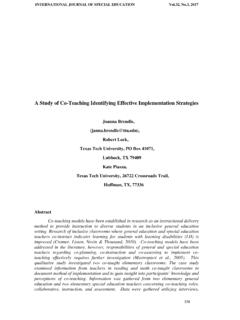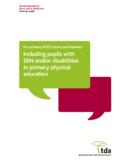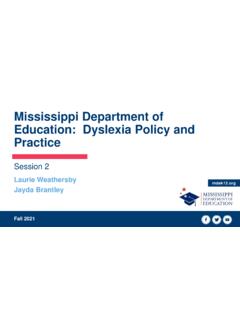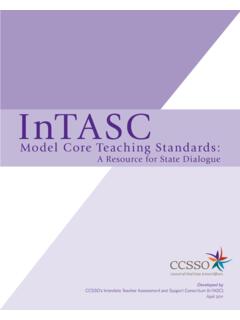Transcription of Understanding and Addressing Learner Diversity
1 Student Supports169 Understanding and Addressing Learner Diversity assessment and Accountability Comprehensive CenterIn successful districts and schools, students reach high levels of academic achievement and are fully prepared for success in a wide variety of postsecondary educational and career options, regardless of their backgrounds and starting points. To reach this common goal for today s extraordinarily diverse students , districts and schools must organize themselves to ensure that a wide variety of programs, curricular and instructional approaches, and pathways to success are made available to all described in the sections of this chapter that follow, student Diversity has many dimensions, including sig-nificant individual and group differences in culture, ethnicity, gender, previous educational experiences, optimal modes of learning.
2 And groups of students with unique sorts of challenges, including the socio-economically disadvantaged, English language learners , and students with students must be taught the rigorous standards-based academic content that will enable them to be profi-cient. Yet, the reality of Learner Diversity challenges school districts and schools to provide rigorous programs that meet students where they are academically (which may be substantially below grade level), maximize their growth as learners , and accelerate their learning to close achievement gaps.
3 It is not surprising that diverse students have differentiated needs. In low-achieving schools with many low-achieving students , an action plan to accelerate the learning of all students will:Ensure that all students have access to rigorous, standards-based instructional programs which meet their 1. individual the needs of individual students . 2. Provide flexibility, and choice wherever possible, in curriculum and instructional programs that meet indi-3. vidual teachers with the professional development they need to address Learner Monitor the implementation of instructional strategies effective with diverse groups of Measure student learning during instruction to ensure the effectiveness of instruction with all students and 6.
4 To alter instruction as needed ( formative assessment ).Address student learning needs in a timely way to ensure continuous, accelerated Monitor individual student growth with common local assessments employing multiple measures ( formative 8. assessment ).Monitor the achievement of diverse groups of students through data aggregated by group to ensure the suc-9. cess of curriculum and instructional programs with all students . Use data to provide tailored instruction based on each student s level of achievement and ongoing The central challenge in a district and school action plan Addressing Learner Diversity is to ensure that the pro-grams and learning opportunities offered have sufficient academic rigor to maximize student growth while having sufficient flexibility to meet the diverse needs of all students and to ensure that the differentiated needs of each student are successfully PrinciplesFor DistrictRecognize the
5 Diversity of students as learners and offer powerful programs that provide the differentiated 1. learning opportunities that will accelerate the achievement of all students . Develop district policies focused on meeting the learning needs of all Develop community partnerships to support students at home, in the community, and at school. 3. Student Supports170 Identify and implement the variety of programs and curricula that will accelerate the learning of diverse 4. district-wide professional development about Learner Diversity and the differentiated instruction 5.
6 Necessary to maximize the learning of all timely and robust data analysis directly relevant to making improvements in instruction and achieve-6. ment for diverse learners . Monitor individual student growth throughout the school year and analyze aggregated data by school and 7. mid-course corrections to address newly-identified student needs and overcome achievement Partner with school staff, student families, and students to ensure a common commitment to intensive 9. efforts to increase student achievement.
7 For SchoolRecognize the Diversity of students as learners and offer powerful programs that provide the differentiated 1. learning opportunities that will accelerate the achievement of all to time for faculty to: 2. engage in discussions of the needs of diverse learners and how those needs can be identified in the classroom; identify and use school-wide strategies for Addressing those needs; and, identify the methods and criteria for monitoring the success of these strategies. Implement the shared strategies and monitor them to make mid-course corrections as needed.
8 3. Develop community support for the school and its work among parents and the surrounding community; 4. provide them with meaningful action clearly within the school and the school community about the achievement of diverse groups 5. of students , analyzing ongoing school successes and challenges, and committing to continuous improvement in the achievement of all students . References and Resources The following resources describe systemic reforms intended to serve all learners in their full Diversity . Buck Institute for Education: Project-Based Learning: Resources.
9 Retrieved from : The California Center for College and Career. Resources and Report: Expanding Pathways. Retrieved from Implementation Research Network, ~nirn/ for 21st Century Skills. ( ). MILE Guide: Milestones for improving learning & education. Retrieved from









